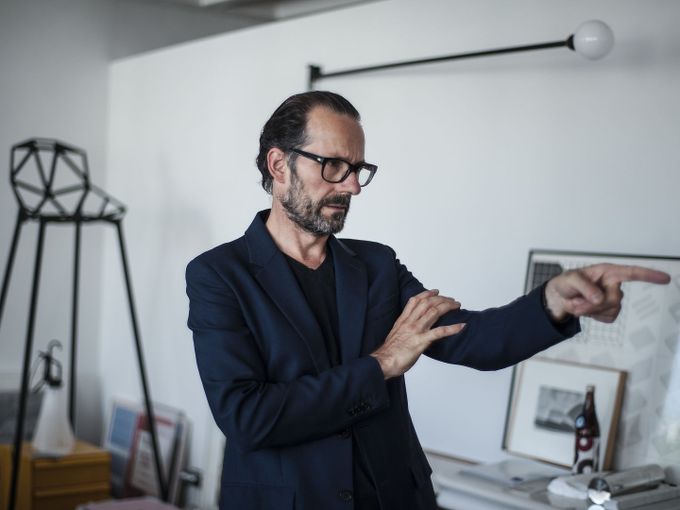Hacking is a creative act
A conversation with Konstantin Grcic

Even though Konstantin Grcic’s current exhibition is entitled ‘New Normals’: nothing here is normal. The Allstar office chair, for example, is attached between scaffolding poles with exercise bands. And the designer has stuck antennas on the plastic Stool-Tool seats. At the Haus am Waldsee in Berlin, Grcic is showing a series of installations for which he has combined his own designs with anonymous industrial materials and products. In connection with the exhibition, Grcic talks about hacking products, the right degree of staging and why an exhibition does not need to please all visitors.
For the current exhibition ‘New Normals’, you have modified your own furniture with small interventions, or hacked it, as you refer to it. One of your designs for Vitra is a desk called ‘Hack’. What interests you about the practice of hacking?
Hacking is a form of appropriation and customisation. You adapt things to your own needs and make them more functional. It’s a creative act. I find the open dimension of it interesting – you are challenged to engage with a product, to extend it, to grow it, to hack it. A commercial product that is in some way unfinished and only becomes finished through the intervention of the user – that’s a paradigm shift. Of course, this idea comes from the tech world, where it’s easier to implement. Each of us makes a smartphone our own through apps and personal settings. We set it up the way we want it. Furniture is, of course, much more inert, but it does lend itself to such an approach, much more so than coffee machines or cars. Furniture can be rebuilt or painted, a hole can be drilled, castors can be screwed on.

What properties does a product or piece of furniture need to be hackable?
Things should be simple, generic. And cheap – that also plays a role. If something is cheap, we don’t worry so much about drilling a hole in it. At the beginning of this semester, I did a project with students at the University of Fine Arts in Hamburg: each student was given a ‘Lack’ table from Ikea and asked to make something new out of it. You know the table: it’s quite simple, a square top, four legs, so it’s well suited for such a project.For you as a designer, how important is the way people actually use your furniture? In the exhibition at the Haus am Waldsee, you also address alternative possibilities of use through the interventions, such as the two sofas pushed together to form a trampoline.
For me, the ideal situation is when things are actually used. It is a form of empowerment. In the sense of: this is mine, I do with it what I want. People make a connection with the objects. As a designer, I obviously think about who a product is intended for during the design process and how it can be used. But I don’t want to dictate anything. I just try to offer something. What eventually happens to it – that’s something I can’t control, nor do I have any desire to do so. But I do pay attention to it and am happy to observe how people use my designs.

The Haus am Waldsee is a special exhibition venue. What influence did that have on the concept for ‘New Normals’?
I found the fact that the house at Lake Waldsee was originally a private villa very challenging. I didn’t want to simply outfit the house with my furniture. How do you design an exhibition in which furniture becomes an exhibit object and not merely furnishing? We experimented with a lot of different ideas, some of them elaborately staged, in order to separate the exhibition from the architecture.
You mean you wanted to work with elements like pedestals, partitions or curtains?
Exactly, we designed entire rooms during the preparations. That was quite fun, and as a process it was helpful. But it didn’t feel right.Why is that?
These days, there is greater awareness of the resources required to implement something. What materials are required, what’s the energy expenditure? Does what I produce end up in the rubbish bin at the end of the exhibition? There is very little staging in this exhibition. Sometimes it’s just a matter of the right position in the room. Some objects are deliberately placed so that they don’t relate to a wall. So that visitors don’t make a rational connection between the house and the furniture. So they don’t ask whether the chair here in this room belongs to someone and what function it has. The hope was to create powerful images with a few limited interventions. I wanted to play around with my own designs and try out different scenarios without it being saddled with excessive meaning.
And how have visitors reacted to this?
The concept demands a lot of imagination on the part of the visitors. They have to engage with it. You can like it, but you can also reject it. An exhibition doesn’t need to please everyone. I often find exhibitions that I don’t understand right away, or that I don’t even like at first, to be particularly stimulating. They frequently end up having the greatest impact.The exhibition ‘New Normals’ is open until 08.05.2022 at the Haus am Waldsee in Berlin.
Publication date: 2.3.2022
Author: Jasmin Jouhar
Images: Florian Boehm


